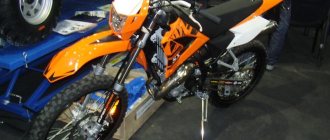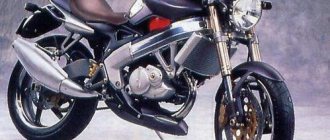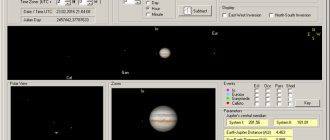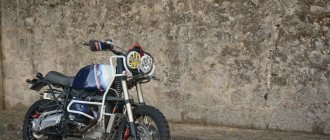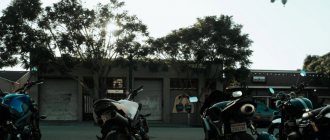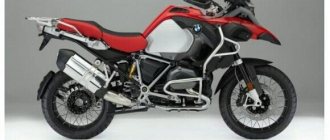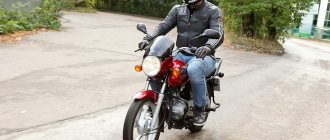The fifth stage of Dakar 2022 presented participants with a grueling 662 kilometers of distance, filled with difficult terrain and difficult navigation with skillfully hidden control points.
One of the favorites of the Dakar Rally 2022, the pilot of the MONSTER ENERGY HONDA TEAM 2022, Juan Barreda Bort, fell into one of these navigation traps.
Everything started well for the Spaniard, but on one of the sections he got quite lost, which ultimately only led to 17th place according to the results of the stage, which dropped Bort to 9th place in the overall standings.
Pablo Quintanilla also showed little difference, exactly the same problems, 13 lost minutes and 10th place for ROCKSTAR ENERGY HUSQVARNA FACTORY RACING in stage 5. But Xavier de Soltreit, a “private owner” who competes for HT RALLY RAID HUSQVARNA RACING, continues to hold the top spot.
Honda, on the contrary, is clearly moving forward and confidently passes stage after stage! Kevin Benyavides, despite a hard fall, was able to pull himself together, win the stage and claim 1st place in the overall standings!
Toby Price, the face of KTM, continues to adhere to the “do no harm” tactic and is steadily moving towards the goal, passing the stage a little slower, but safely, saving energy for the final part of the race. In general, this tactic was justified; Price finished third and moved up to fourth place in the overall standings.
Lorenzo Santolino on Sherco also moves quite steadily. Despite the same problems with navigation, he finishes in 4th place and rises to 6th place in the overall standings.
José Ignacio Corneo Florimo, Kevin Benavides' team-mate, also showed excellent results, handled the track well and finished second, just a minute behind Benavides, and rounded out the top three in the general classification.
Ahead of the pilots is a double marathon stage, where the participants will have to spend the night without technical support from the team, so it’s still too early to predict anything, stay tuned!
*** Friends, for technical reasons we had to delete our YOUTUBE channel and create a NEW one!
Since promoting a channel from scratch is a very difficult task, we ask you to support the INMOTO channel with a subscription, and the videos released on it with likes and comments!
Thank you all for your support, we thank you for reading and watching us, see you again on the site and YOUTUBE!
Made in Japan
In the short history of rally raids, dating back only a few decades, motorcycles from Japan, Germany, Austria and Italy left a noticeable imprint.
Yamaha XT500
In 1976, a motorcycle built specifically for sand racing was presented to the public. The bike was powered by a half-liter air vent, producing 30 hp on the go. power at 5800 rpm. The motorcycle was 2170 mm long and weighed 139 kilograms.
Honda NXR 750V/800V
The motorcycle debuted in 1986. He was destined to rise to the highest level of the Dakar marathon three times: in 1986, 1987 and 1988. The bike’s engine is a V-shaped 65-horsepower (there was also a 75-horsepower version) power unit with a liquid cooling system. The civilian version of the motorcycle was sold under the name XRV750 Africa Twin and gained fame as the “king of around the world”, thanks to which it remains popular today.
Yamaha YZE 750T/850T Tenere
The model debuted in 1991 and managed to win the Dakar seven times, one of the most difficult tests for equipment and pilots. The developers equipped the bike with a two-cylinder in-line 950 cc liquid-cooled engine. Initially, the engine produced 75 hp. maximum power, but was modernized several times, as a result of which the “return” indicators changed. The civilian version of the combat bike, named XTZ 750 Super Tenere, is still popular today among “work tourists” all over the world.
Characteristics
Suspension travel: 300/280 mm (front/rear), ground clearance - 300 mm, dry weight - 180 kg, maximum speed - 190 km/h.
Husqvarna 125te (Rally Concept)
It differs from a regular stock “two-stroke” in two gas tanks with a total capacity of 27.5 liters, fairings, and electrical appliances. Interestingly, in the rear pendulum of this “Dakar” motorcycle there is a reservoir for two-stroke oil - you can refuel with gasoline at certain points of the marathon, but getting oil in the desert is not an easy task. That’s why I take everything I own with me.
Otherwise, everything is standard: six-speed gearbox, hydraulic clutch, kick starter.
The current Dakar 2016 marathon also includes Husqvarna 450 rally, Husqvarna fr450, Kawasaki kxf 450, Suzuki rmz 450 rallye
Let us remind you that you can sell or find new or used equipment in our “Equipment Sales” section.
Made in Germany
BMW R 800 GS/BMW GS 980 R
In the early 80s of the last century, the German motorcycle giant prepared bikes specifically for racing in the desert. The basis for the motorcycles was the BMW R 80 GS with its air-oil-cooled boxer engine. Engine 797 cc. was capable of developing 55/69 hp. maximum power.
With a reinforced frame and an extended swingarm, the motorcycle is more stable and reliable. Dry weight (depending on version) was 155/230 kg, and fuel capacity was 38 or 60 liters.
BMW F 650 RR Dakar
In 1998, one of the iconic motorcycles of our time saw the light of day - the BMW F 650 RR Dakar, which managed to win the Dakar marathons in 1999 and 2000. The merits of the motorcycle faded after KTM "unleashed" its rally bikes and left other manufacturers far behind. The champion Bavarian was powered by a single-cylinder 700 cc 75-horsepower liquid-cooled engine. The bike's suspension travel is 300/300 mm, dry weight is 168 kg. The original system of fuel tanks (5 pieces: two in front, one under the seat, two in the back) made it possible to fill up to 45 liters of gasoline while maintaining normal weight distribution and, accordingly, controllability.
Yamaha WR450F rally
The motorcycle is designed on the basis of the YZF motocross bike. It weighs 123 kilograms, has a thirty-liter tank, an injector and a kick starter. Didn’t expect to see “kick” in the twenty-first century? Admittedly, we do too. However, Yamaha engineers thought a little differently. The philosophy behind this bike is weight. The lighter the bike, the faster it can go, the longer it will take before the rider runs out of steam.
The engine is an improved version of the YZ. The Dakar motorcycle is equipped with a five-speed gearbox and a four-valve cylinder head with a compression ratio of 12.5. In addition, despite its massive appearance, the bike is not without aerodynamic properties. Overall, an excellent desert conqueror.
Made in Italy
Cagiva Elefant 906 SP
The Italian project was focused on winning the most difficult race in the world - the Paris-Dakar rally raid. In 1990 and 1994, Eddie Oriol managed to win the race on this bike, thus realizing the idea of the ambitious Italians. As a power unit, the motorcycle used a proprietary L-shaped engine from Ducati with an equally proprietary desmodromic valve drive. The 904 cc air-cooled engine produced 78 hp. maximum power at 8000 rpm, and its gas distribution mechanism had only two valves per cylinder. Experts from a well-known motorcycle grandee in the person of Ducati took part in the development of the motorcycle.
Honda CRF450 RALLY 2016
An updated bike, with which Hodna entered the expanses of South America back in 2013. The motorcycle for Dakar this year uses a carbon subframe and a six-speed gearbox. Unlike Yamaha, Honda engineers did not make life difficult for the rider and used an electric starter on the rally motorcycle. A reasonable decision, considering that motorcyclists have to cover 600-700 kilometers a day, half of which is far from an easy trip, but a difficult special stage. Therefore, you have to fall often and fall painfully.
Many riders of the current Dakar Rally 2016 have already suffered injuries. For example, Czech motorcyclist Andrei Klymchev rode the sixth stage with an injured ankle. The Honda crf450 rally has a tank for 33.7 liters of fuel, which undoubtedly gives a certain advantage over the Yamaha, at least in terms of power reserve.
Made in Austria
KTM 660/690 LC4 Adventure
In 1999, the Austrians created a motorcycle that, with some changes, managed to become a five-time champion in the Dakar rally-raid. The bike was equipped with a 654 cc single-cylinder four-valve engine, the maximum power of which was 52 hp. at 7000 rpm. The inverted fork with a 50 mm stanchion diameter had a travel of 270 mm, and a rear travel of 310 mm. The dry weight of the motorcycle was 170 kg, the fuel capacity was 55 liters.
KTM 450 Rally
The KTM 450 Rally was developed in response to changes in rally raid regulations. In 2010, a motorcycle with a massive chrome-molybdenum frame was presented to the public. The motorcycle is powered by a single-cylinder 450 cc engine. Suspension: Upside-down fork at the front and adjustable WP shock absorber at the rear. The dry weight of the bike is a little less than one and a half centners.
What kind of motorcycles are used to conquer the Dakar?
Dakar 2016 has already become history, the 2022 season is just around the corner.
However, it is no less interesting to find out what the heroes of this legendary rally raid drive. The Dakar Rally, which is taking place for the thirty-eighth time, still gathers its fans in front of televisions and computer monitors. Of course, equipment manufacturers have long understood this - prestigious places on the Dakar podium work better than any advertising.
This year is no exception - almost all leading motorcycle manufacturers are present in one way or another in the standings. The leader at the end of six stages, HRC HONDA team rider Paulo Goncalves, conquers the vastness of Argentina and Bolivia on a Honda CRF450 rally motorcycle. At the moment, this “Dakar motorcycle” shows the best results in terms of technical reliability and controllability.
Let us remind you that according to the recently changed regulations, the maximum engine capacity of the Dakar motorcycle was reduced to 450 cubic meters. Rally organizers explained this by saying that drivers sometimes do not need excess power at the rear wheel. By doing this, they want to protect athletes from unnecessary risk. Thanks to modern suspensions, rally motorcycles pass special stages at speeds of about 150 kilometers per hour (with a modern displacement of 450 cubic meters). However, this is quite enough to get a hefty dose of adrenaline.
This year's Dakar motorcycles:
- KTM 450, KTM 450 Rally Replica,
- HONDA CRF450 RALLY,
- SHERCO TVS,
- YAMAHA YZ450F, YAMAHA WR450F RALLY,
- Husqvarna TE125, Husqvarna 450.
Almost all bikes at Dakar 2016 are four-stroke. However, the two-stroke one hundred and twenty heel from Husky (!) also participates in the overall standings. By the way, this is already the third attempt of this motorcycle to conquer the toughest rally in the world.
001_MOTO_0910_066
“A challenge for those who dare, a dream for those who remain” - this phrase, said by the founder of the Paris-Dakar race Thierry Sabin, has become the motto of everyone who dreams of conquering the legendary race; it haunts those who once took part. We will try to understand the essence of some practical things and motivations necessary for those who decide. Our interlocutor is Alexey Naumov , an athlete who stood at the start of the only Dakar rally marathon that never took place (he plans to go there again this year).
Navigation and routes
Currently, given the fact that roads at the Dakar Rally sites are predominantly a relative concept, each rally participant is provided with an ERTF Unik II navigation device and an IriTrack monitoring device. The IriTrack device is a GPS tracker with feedback via the Iridium network, combined with an Iridium satellite phone, and is used to constantly track the participant's position, as well as to communicate with the crew in case of emergency to organize assistance. The Unik II device is used to control the distance and for navigation during special stages. However, navigation capabilities are limited to showing the direction to the next navigation point (if the participant’s car is within the visibility radius of the next point). The coordinates of the points are not shown to participants. But if a participant gets lost, he can enter a special unlock code and see the next or all other points on the route, which can allow him to find his way. For each point “opened” by such a code, a temporary penalty is imposed on the participant. On the eve of each stage, participants receive a legend - an indicative movement diagram with the most important landmarks and checkpoints. Navigation is carried out only according to the “legend”; if a GPS device is used, the crew is removed from the race.
The Dakar Rally route is laid out on public roads (not always roads) without the use of special measures to restrict the movement of vehicles. Stages take place daily. The distance of each stage (road sections combined with a high-speed section) is 700-900 km. The routes of the stages run through sands, barchans, and dunes. The road surface is varied and includes sand, stones, salt marshes, hard rocky soil, etc. The timing coincides with the period when sandstorms or rain often occur in deserts, which complicates the passage of the route.
The route of each stage consists of a high-speed section and one or two road sections (called “liaisons”), which are a section of the route from the resting place to the start place or from the finish to the resting place or start of the next stage.
The high-speed section is the section of the track where the participants compete. At each such section there are several control points - special places on the route in which participants must receive a mark from the judges. Typically, some checkpoints are combined with refueling points (Moto and Quad categories only). Also, at some stages, secret control points are installed, the location of which the participants have no information about. Such checkpoints ensure that rally participants adhere to the route.
Childhood: “Tula” motorcycle, all my friends are boys, surprised traffic cops
– Where does the passion for motorcycles come from?
– This is a story from deep childhood. I don’t remember myself, but my mother told me how I was just a child, and my hands were drawn to motorcycles when I saw them on the streets. Even in my school notebooks I drew motorcycles, not flowers.
I don't know where this comes from. In our family, no one was involved in motorsports, or professional sports in general. My parents hoped until the very end that this would pass. It did not pass.
– Tell us about your first motorcycle.
– When I turned 16, I persuaded my parents to buy a motorcycle. Naturally, we agreed that I would only drive around the dacha, through the fields, no public roads. My parents agreed, my dad and I installed a trailer to the car and went to the factory to buy a Tula motorcycle. It was 1995 or 1996.
I don't remember how much it cost, but I remember that Tula motorcycles were standard red. But when we arrived, there were two motorcycles on display - a metallic crimson and a metallic green. They don’t look like commonplace red ones at all. I remember my dad saying: “We have this.” The saleswoman said: “No, no, these are exhibition samples, we take them to exhibitions, they are not for sale.” But dad persuaded her. I remember how after this my dad said: “Well, we agreed. Of course, you want raspberry? I say: “No, this is some girly nonsense.” And we took the green one.
A girl’s story – it wasn’t about me even then. I have two older brothers, all my life I was only friends with boys, I played football in the yard, rode bicycles, and did not play with dolls. The only sign of girliness was that I loved to sew clothes for dolls.
They say there are tomboy girls. But with all this, I like to dress beautifully, I follow fashion. It’s not like my hands are always up to my elbows in oil. But it’s been this way since childhood that it’s easier for me and the boys to find a common language. All my friends are guys. Mom told me: I was so looking forward to having a girl, I dreamed so much that there would be dresses and braids. And I didn’t like all this at all as a child.
I really liked the motorcycle, I rode it through the fields and vegetable gardens. It was not the most reliable, the vibration was terrible, because of it, bolts and nuts were constantly being unscrewed from it. Now this motorcycle is in my parents' garage at the dacha. But he is absolutely on the move.
– What was it like to be a 16-year-old girl on a motorcycle in Russia in the 90s?
“My relatives knew that I was obsessed with motorcycles. When I started going to the city, I, of course, aroused everyone’s interest. There are a lot of girls on motorcycles now. I sometimes go to my old coach, he only has girls. I don’t know why this is so. He is also surprised and says that they have gone crazy.
And then it happened that traffic police stopped me, I didn’t have a license, I managed to talk them out of it. They said: “Oh, you’re a girl! How long does it take? How much is the engine? They even forgot to ask for the right. But I didn’t have any accidents in my city. At most, the mirror touched someone.
Even then, motorcyclists went to the observation deck of the Lenin Mountains. And now, in my opinion, they are gathering there. Everyone knew each other, and there were a lot of girls on motorcycles. But I wasn’t particularly interested in driving around the city, I quickly gave up and drove on off-road tracks and started competing.
– Have you ever ridden without a helmet?
- Not once. I take defense very seriously. A helmet is needed even if you are going to a nearby stall for beer. Practice shows that all the most fatal stories happen precisely in situations where a person needs to drive three meters and is not wearing a helmet.
At races according to the rules, even if you just need to drive 100-200 meters around the camp, you still need to wear a helmet. Otherwise I will be fined.
– How much maximum did you push on a regular road?
– About 200 kilometers on the Simferopol highway, this was in the early 2000s. For a very short distance, but it was enough for me to understand what high speed is. This is when you lower your eyes to the speedometer, then look up, and the situation on the road has changed radically. I realized that this is not fun at all.
At that time I had a Yamaha R6 road motorcycle. I had it for a couple of months, after which I sold it.
– Were you friends with bikers?
– I still don’t understand anything about them. Here are biker clubs, like the Night Wolves. They have some kind of hierarchy - the president of the club, deputies, someone responsible for how they travel somewhere in formation, someone responsible for legal issues. Everyone has it written on their vest who is responsible for what. Why do people play this? There are a lot of rich businessmen there - apparently, something is missing in life.
I'm not judging in any way. It’s just a different culture, not close to me. But, of course, there are biker friends.

